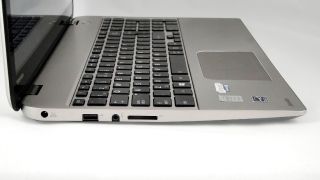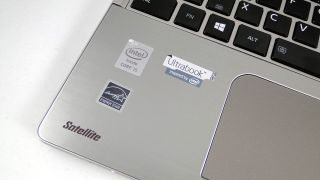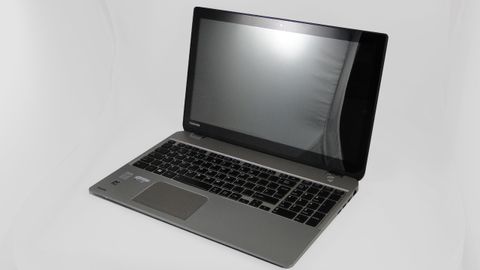Why you can trust TechRadar
As we've detailed, the Ultrabook standard is demanding. So it's not a huge shock to see this relatively affordable laptop typically not exceed it by wide margins.
CPU-wise, we're talking Intel Core i5-4200U. It's a dual-core chip with a 1.6GHz nominal clockspeed and top Turbo speed of 2.6GHz. For most users, it's likely all the CPU you'll need in a portable.
As for graphics, like most Ultrabooks the Toshiba Satellite U50t-A-10F makes do with the Core i5-4200U's integrated 3D core, namely the Intel HD Graphics 4400. It's a mid-range core with 20 execution units and a reasonable compromise given the requirement for extensive battery life.
For storage, Toshiba has gone for a 32GB SSD cache and a 750GB magnetic hard drive. This is probably the first real indicator that building down to a price was a factor. In an ideal word, you'd have pure solid state storage.

So, the big question is whether this kind of SSD and magnetic hybrid solution (the two drives show up as a single 687GB partition as shipped from the factory) can provide a similar end-user experience to a true solid-state drive.
Another area where cost cutting is pretty obvious involves the screen. 15.6 inches is generously enough proportioned. But the 1,366 by 768 native resolution is pretty stingy by any metric. Even cheapish tablets like the Nexus 7 now sport full-HD panels with 1,920 horizontal pixels.
Indeed many phones do just that too and several tablet go beyond full HD at a fraction of the price of the Toshiba Satellite U50t-A-10F. That's not an entirely fair comparison, of course.
Other cheap Ultrabooks like the Lenovo IdeaPad U410 Touch suffer the same modest panel resolution. But it's one of the most obvious compromises you'll have to make in return for this model's aggressive pricing.

Elsewhere, we're talking 6GB of DDR3 memory, happily configured in high-performance dual-channel configuration and a hybrid storage solution. Regards the battery, Toshiba doesn't quote the capacity of the lithium pack. But it does claim seven hours in Mobile Mark. And of course, it must meet those minimum Ultrabook specifications for battery life.
For networking, you get a gigabit LAN port, b/g/n spec wireless and Bluetooth 4.0. Which is pretty much par for the course. Ports and connectivity, meanwhile, take in two USB 3.0 ports and USB USB 2.0, an SD card reader, a dual-function headphone and mic jack and an HDMI socket for video out.
For the most part, that little lot is the bare minimum of ports and sockets you'd expect to see. On the other hand, few users will actually need more. If, for instance, something fancy like a Lightning connector is a deal breaker, you'll know instantly this isn't the system for you.
Finally, there are the proportions and mass. At 23mm thick, it's slim for a 15.6-inch laptop. But at 2.4kg, it's hardly a lightweight.
Technology and cars. Increasingly the twain shall meet. Which is handy, because Jeremy (Twitter) is addicted to both. Long-time tech journalist, former editor of iCar magazine and incumbent car guru for T3 magazine, Jeremy reckons in-car technology is about to go thermonuclear. No, not exploding cars. That would be silly. And dangerous. But rather an explosive period of unprecedented innovation. Enjoy the ride.

